Today massive, sport-shifting thoughts are fewer prevalent. New and improved techniques are the driving power powering modern day scientific investigation and discoveries. They allow for researchers — together with chemists like me — to do our experiments a lot quicker than ahead of, and they glow gentle on spots of science hidden to our predecessors.

Crystal jellyfish comprise glowing proteins that scientists repurpose for an countless

array of studies.
A few reducing-edge procedures — the gene-modifying instrument CRISPR, fluorescent proteins and optogenetics — were all encouraged by character. Biomolecular resources that have worked for microbes, jellyfish and algae for thousands and thousands of a long time are now currently being applied in medication and biological study. Specifically or indirectly, they will alter the lives of each day folks.
Bacterial protection systems as genetic editors
Microbes and viruses fight themselves and one particular a different. They are at frequent biochemical war, competing for scarce sources.
One of the weapons that germs have in their arsenal is the CRISPR–Cas technique. It is a genetic library consisting of brief repeats of DNA collected over time from hostile viruses, paired with a protein identified as Cas that can slice viral DNA as if with scissors. In the purely natural world, when microbes are attacked by viruses whose DNA has been stored in the CRISPR archive, the CRISPR-Cas method hunts down, cuts and destroys the viral DNA.
Experts have repurposed these weapons for their very own use, with groundbreaking result. Jennifer Doudna, a biochemist centered at the College of California, Berkeley, and French microbiologist Emmanuelle Charpentier shared the 2020 Nobel Prize in Chemistry for the enhancement of CRISPR-Cas as a gene-editing method.

French microbiologist Emmanuelle Charpentier (still left) and U.S. biochemist Jennifer Doudna shared the 2020 Nobel Prize in Chemistry for growth of the CRISPR–Cas gene enhancing approach.
The Human Genome Project has provided a almost total genetic sequence for humans and presented scientists a template to sequence all other organisms. Even so, in advance of CRISPR–Cas, we researchers did not have the equipment to easily obtain and edit the genes in living organisms. Today, thanks to CRISPR-Cas, lab operate that utilized to choose months and several years and price tag hundreds of countless numbers of pounds can be completed in less than a week for just a several hundred dollars.
There are additional than 10,000 genetic ailments caused by mutations that occur on only a person gene, the so-termed solitary-gene issues. They have an effect on thousands and thousands of people today. Sickle cell anemia, cystic fibrosis and Huntington’s disorder are amongst the most properly-known of these diseases. These are all obvious targets for CRISPR remedy mainly because it is significantly less difficult to fix or swap just just one defective gene relatively than needing to suitable mistakes on several genes.
For instance, in preclinical experiments, researchers injected an encapsuled CRISPR procedure into patients born with a scarce genetic disease, transthyretin amyloidosis, that triggers deadly nerve and heart conditions. Preliminary outcomes from the analyze demonstrated that CRISPR–Cas can be injected specifically into individuals in this kind of a way that it can find and edit the defective genes connected with a disease. In the 6 individuals provided in this landmark work, the encapsuled CRISPR–Cas minimissiles achieved their goal genes and did their job, leading to a sizeable drop in a misfolded protein connected with the condition.
Jellyfish mild up the microscopic entire world
The crystal jellyfish, Aequorea victoria, which drifts aimlessly in the northern Pacific, has no brain, no anus and no toxic stingers. It is an not likely applicant to ignite a revolution in biotechnology. Yet on the periphery of its umbrella, it has about 300 image-organs that give off pinpricks of inexperienced light-weight that have adjusted the way science is conducted.
This bioluminescent light-weight in the jellyfish stems from a luminescent protein known as aequorin and a fluorescent molecule referred to as green fluorescent protein, or GFP. In modern biotechnology GFP functions as a molecular lightbulb that can be fused to other proteins, enabling researchers to track them and to see when and in which proteins are becoming made in the cells of living organisms. Fluorescent protein technological know-how is utilized in thousands of labs every working day and has resulted in the awarding of two Nobel Prizes, one particular in 2008 and the other in 2014. And fluorescent proteins have now been observed in quite a few a lot more species.

Countrywide Institute of Basic Medical Sciences/NIH
Martin Chalfie, Roger Y. Tsien and Osamu Shimomura shared the 2008 Nobel Prize

in Chemistry for their groundbreaking function on environmentally friendly fluorescent protein.
This engineering proved its utility the moment yet again when researchers established genetically modified COVID-19 viruses that specific GFP. The resulting fluorescence can make it possible to adhere to the path of the viruses as they enter the respiratory technique and bind to surface area cells with hairlike structures.
Algae permit us enjoy the brain neuron by neuron
When algae, which depend on sunlight for expansion, are placed in a large aquarium in a darkened area, they swim around aimlessly. But if a lamp is turned on, the algae will swim towards the light. The single-celled flagellates — so named for the whiplike appendages they use to move close to — really don’t have eyes. In its place, they have a framework termed an eyespot that distinguishes involving mild and darkness. The eyespot is studded with light-weight-delicate proteins identified as channelrhodopsins.
In the early 2000s, researchers found out that when they genetically inserted these channelrhodopsins into the nerve cells of any organism, illuminating the channelrhodopsins with blue mild brought on neurons to fire. This procedure, recognised as optogenetics, includes inserting the algae gene that would make channelrhodopsin into neurons. When a pinpoint beam of blue light is shined on these neurons, the channelrhodopsins open up, calcium ions flood by means of the neurons and the neurons hearth.
Using this tool, scientists can encourage groups of neurons selectively and frequently, thus attaining a more exact comprehension of which neurons to concentrate on to deal with unique disorders and diseases. Optogenetics may hold the vital to dealing with debilitating and fatal brain conditions, these types of as Alzheimer’s and Parkinson’s.

National Institute on Getting old/NIH
Optogenetics could support deal with Alzheimer’s condition, which is characterized by the buildup of misfolded proteins named amyloid plaques.
But optogenetics is not only handy for comprehending the mind. Scientists have utilised optogenetic tactics to partially reverse blindness and have discovered promising success in medical trials using optogenetics on people with retinitis pigmentosa, a group of genetic issues that break down retinal cells. And in mouse experiments, the method has been applied to manipulate heartbeat and regulate bowel actions of constipated mice.
What else lies in nature’s toolbox?
What undiscovered strategies does character continue to keep for us?
According to a 2018 study, persons depict just .01% of all residing matters by mass but have prompted the loss of 83% of all wild mammals and fifty percent of all plants in our quick time on Earth. By annihilating nature, humankind may possibly be shedding out on new, potent and lifetime-altering tactics devoid of having even imagined them.
Immediately after all, no just one could have foreseen that the discovery of a few groundbreaking processes derived from character could improve the way science is performed.![]()
This write-up is republished from The Discussion underneath a Creative Commons license. Read the authentic short article.


More Stories
Transforming Appearances with the Perfect Hairpiece Touch
Exploring the Wonders of Modern Sciences
How Sciences Unlock the Mysteries of the Universe